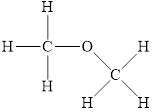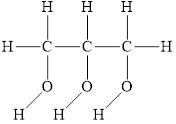
(a)
Interpretation:
The intermolecular interactions that operate in
Concept introduction:
There are three types of interactions through which the molecules are stabilized. They are hydrogen-bonding interactions, the dipole-dipole interactions and the induced dipole interactions. These interactions influence the properties of the compounds like boiling point, melting point and so on.
Answer to Problem 39E
The intermolecular interactions that operate in
Explanation of Solution
In all molecular substances, the intermolecular interactions exist. These interactions are induced dipole interactions, dipole-dipole interactions and hydrogen bonding.
The structure of

Figure 1
The molecule has electronegative atom
The intermolecular interactions that operate in
(b)
Interpretation:
The intermolecular interactions that operate in
Concept introduction:
There are three types of interactions through which the molecules are stabilized. They are hydrogen-bonding interactions, the dipole-dipole interactions and the induced dipole interactions. These interactions influence the properties of the compounds like boiling point, melting point and so on.
Answer to Problem 39E
The intermolecular interactions that operate in
Explanation of Solution
In all molecular substances, the intermolecular interactions exist. These interactions are induced dipole interactions, dipole-dipole interactions and hydrogen bonding.
The structure of

Figure 2
The molecule has electronegative atom
The intermolecular interactions that operate in
(c)
Interpretation:
The intermolecular interactions that operate in
Concept introduction:
There are three types of interactions through which the molecules are stabilized. They are hydrogen-bonding interactions, the dipole-dipole interactions and the induced dipole interactions. These interactions influence the properties of the compounds like boiling point, melting point and so on.
Answer to Problem 39E
The intermolecular interactions that operate in
Explanation of Solution
In all molecular substances, the intermolecular interactions exist. These interactions are induced dipole interactions, dipole-dipole interactions and hydrogen bonding.
The structure of

Figure 3
The molecule has electronegative atom
The intermolecular interactions that operate in
(d)
Interpretation:
The intermolecular interactions that operate in
Concept introduction:
There are three types of interactions through which the molecules are stabilized. They are hydrogen-bonding interactions, the dipole-dipole interactions and the induced dipole interactions. These interactions influence the properties of the compounds like boiling point, melting point and so on.
Answer to Problem 39E
The intermolecular interactions that operate in
Explanation of Solution
In all molecular substances, the intermolecular interactions exist. These interactions are induced dipole interactions, dipole-dipole interactions and hydrogen bonding.
The structure of

Figure 4
The molecule has electronegative atom
The intermolecular interactions that operate in
(e)
Interpretation:
The intermolecular interactions that operate in
Concept introduction:
There are three types of interactions through which the molecules are stabilized. They are hydrogen-bonding interactions, the dipole-dipole interactions and the induced dipole interactions. These interactions influence the properties of the compounds like boiling point, melting point and so on.
Answer to Problem 39E
The intermolecular interactions that operate in
Explanation of Solution
In all molecular substances, the intermolecular interactions exist. These interactions are induced dipole interactions, dipole-dipole interactions and hydrogen bonding.
The structure of

Figure 5
The molecule does not have any has electronegative atom. This means the polarity is not present in the molecule. This molecule can form bond with other molecule through the induced dipole interactions. Therefore, the dominant intermolecular interaction in this molecule is induced dipole interaction.
The intermolecular interactions that operate in
Want to see more full solutions like this?
Chapter 15 Solutions
Introductory Chemistry: An Active Learning Approach
- Assign all the protonsarrow_forwardAssign all the carbonsarrow_forward9 7 8 C 9 8 200 190 B 5 A -197.72 9 8 7 15 4 3 0: ང་ 200 190 180 147.52 134.98 170 160 150 140 130 120 110 100 90 90 OH 10 4 3 1 2 -143.04 140. 180 170 160 150 140 130 120 110 100 90 CI 3 5 1 2 141.89 140.07 200 190 180 170 160 150 140 130 120 110 100 ៖- 90 129. 126.25 80 70 60 -60 50 40 10 125.19 -129.21 80 70 3.0 20 20 -8 60 50 10 ppm -20 40 128.31 80 80 70 60 50 40 40 -70.27 3.0 20 10 ppm 00˚0-- 77.17 30 20 20 -45.36 10 ppm -0.00 26.48 22.32 ―30.10 ―-0.00arrow_forward
- Assign all the carbonsarrow_forwardC 5 4 3 CI 2 the Righ B A 5 4 3 The Lich. OH 10 4 5 3 1 LOOP- -147.52 T 77.17 -45.36 200 190 180 170 160 150 140 130 120 110 100 90 80 70 60 50 40 30 20 10 ppm B -126.25 77.03 200 190 180 170 160 150 140 130 120 110 100 90 80 70 60 50 40 30 20 10 ppm 200 190 180 170 160 150 140 130 120 110 100 90 80 TO LL <-50.00 70 60 50 40 30 20 10 ppm 45.06 30.18 -26.45 22.36 --0.00 45.07 7.5 1.93 2.05 -30.24 -22.36 C A 7 8 5 ° 4 3 7.5 7.0 6.5 6.0 5.5 5.0 4.5 4.0 3.5 3.0 2.5 2.0 1.5 1.0 ppm 9 8 5 4 3 ཡི་ OH 10 2 7.5 7.0 6.5 6.0 5.5 5.0 4.5 4.0 3.5 3.0 2.5 2.0 1.5 5 4 3 2 that th 7 I 7.0 6.5 6.0 5.5 5.0 4.5 4.0 3.5 3.0 2.5 2.0 1.5 115 2.21 4.00 1.0 ppm 6.96 2.76 5.01 1.0 ppm 6.30 1.00arrow_forwardCurved arrows were used to generate the significant resonance structure and labeled the most significant contribute. What are the errors in these resonance mechanisms. Draw out the correct resonance mechanisms with an brief explanation.arrow_forward
- What are the: нсе * Moles of Hice while given: a) 10.0 ml 2.7M ? 6) 10.ome 12M ?arrow_forwardYou are asked to use curved arrows to generate the significant resonance structures for the following series of compounds and to label the most significant contributor. Identify the errors that would occur if you do not expand the Lewis structures or double-check the mechanisms. Also provide the correct answers.arrow_forwardhow to get limiting reactant and % yield based off this data Compound Mass 6) Volume(mL Ben zaphone-5008 ne Acetic Acid 1. Sam L 2-propanot 8.00 Benzopin- a col 030445 Benzopin a Colone 0.06743 Results Compound Melting Point (°c) Benzopin acol 172°c - 175.8 °c Benzoping to lone 1797-180.9arrow_forward
- Assign ALL signals for the proton and carbon NMR spectra on the following pages.arrow_forward7.5 1.93 2.05 C B A 4 3 5 The Joh. 9 7 8 1 2 7.5 7.0 6.5 6.0 5.5 5.0 4.5 4.0 3.5 3.0 2.5 2.0 1.5 1.0 ppm 9 7 8 0.86 OH 10 4 3 5 1 2 7.5 7.0 6.5 6.0 5.5 5.0 4.5 4.0 3.5 3.0 2.5 2.0 1.5 1.0 ppm 9 7 8 CI 4 3 5 1 2 7.0 6.5 6.0 5.5 5.0 4.5 4.0 3.5 3.0 2.5 2.0 2.21 4.00 1.5 2.00 2.07 1.0 ppm 2.76arrow_forwardAssign the functional group bands on the IR spectra.arrow_forward
 Introductory Chemistry: An Active Learning Approa...ChemistryISBN:9781305079250Author:Mark S. Cracolice, Ed PetersPublisher:Cengage Learning
Introductory Chemistry: An Active Learning Approa...ChemistryISBN:9781305079250Author:Mark S. Cracolice, Ed PetersPublisher:Cengage Learning World of Chemistry, 3rd editionChemistryISBN:9781133109655Author:Steven S. Zumdahl, Susan L. Zumdahl, Donald J. DeCostePublisher:Brooks / Cole / Cengage Learning
World of Chemistry, 3rd editionChemistryISBN:9781133109655Author:Steven S. Zumdahl, Susan L. Zumdahl, Donald J. DeCostePublisher:Brooks / Cole / Cengage Learning World of ChemistryChemistryISBN:9780618562763Author:Steven S. ZumdahlPublisher:Houghton Mifflin College Div
World of ChemistryChemistryISBN:9780618562763Author:Steven S. ZumdahlPublisher:Houghton Mifflin College Div Introductory Chemistry: A FoundationChemistryISBN:9781337399425Author:Steven S. Zumdahl, Donald J. DeCostePublisher:Cengage Learning
Introductory Chemistry: A FoundationChemistryISBN:9781337399425Author:Steven S. Zumdahl, Donald J. DeCostePublisher:Cengage Learning Chemistry: The Molecular ScienceChemistryISBN:9781285199047Author:John W. Moore, Conrad L. StanitskiPublisher:Cengage Learning
Chemistry: The Molecular ScienceChemistryISBN:9781285199047Author:John W. Moore, Conrad L. StanitskiPublisher:Cengage Learning Principles of Modern ChemistryChemistryISBN:9781305079113Author:David W. Oxtoby, H. Pat Gillis, Laurie J. ButlerPublisher:Cengage Learning
Principles of Modern ChemistryChemistryISBN:9781305079113Author:David W. Oxtoby, H. Pat Gillis, Laurie J. ButlerPublisher:Cengage Learning





